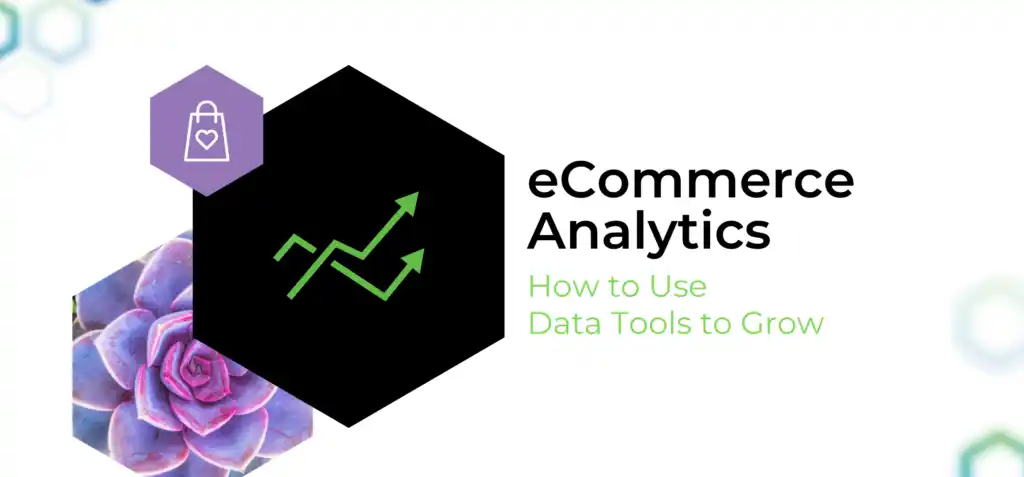
If you’ve heard someone define lead nurturing and thought, “Ummm, isn’t that just marketing?”, you’re not alone.
Lead nurturing and marketing are the same thing, but they’re also different.
Don’t throw your phone at us! We’re about to clear this up. Today’s Apiary POV will alleviate that confusion headache by clarifying:
- What is lead nurturing?
- What kinds of brands are especially suited for lead nurturing?
- Apiary’s 4 MUSTS of lead nurturing
- The most common lead nurturing tactics
What is lead nurturing?
You’ve probably heard an Insta-therapist advise, “You’ve got to meet people where they are”.
Lead nurturing is the wise yoda of marketing who understands that this phrase doesn’t just apply to interpersonal relationships.
In the simplest terms, marketing is the process of generating awareness of the value of your product or service, with the goal of driving revenue.
Lead nurturing is a specific aspect of marketing, which focuses on meeting potential customers where they are so you can build relationships with them over time, with the goal of driving net new and recurring revenue.
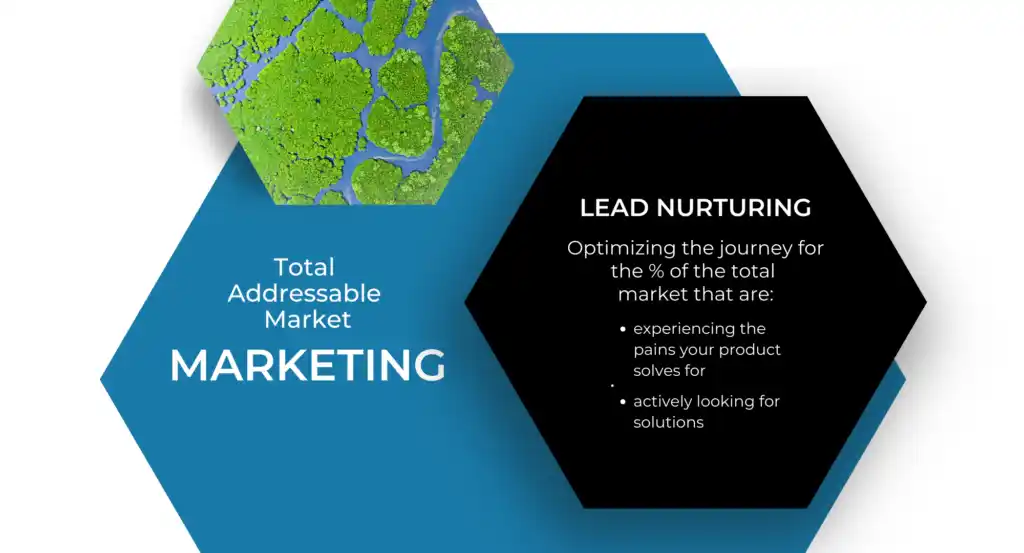
What kinds of brands are especially suited for lead nurturing?
- You sell a complex or high-ticket item
- Your sales process requires buy-in from multiple stakeholders
- Your product or service typically needs a longer sales cycle
- Any brand that cares about lifetime value (LTV)
We have yet to meet a single thriving business (consistent revenue growth YOY) that isn’t intentionally practicing lead nurturing.
If there’s any evidence that building relationships with potential customers/clients could positively influence the buying process (EVERY industry contains evidence that affirms this), lead nurturing is for you.
Lead nurturing efforts create a carefully orchestrated and systematic approach to bringing humans into a brand’s ecosystem and moving them through four key stages:
1. Are they aware of what you’re offering?
2. Are they educated enough to have a point of view?
3. Can they make a decision on purchasing your offering?
4. Do they have everything they need to operationalize your product?
Apiary’s 4 MUSTS of lead nurturing:
Context is everything, which is why we rarely advocate for universal marketing strategies that supposedly apply to every business at every stage of the life cycle.
Having said that, there are 4 essential characteristics present in every successful lead nurturing program we’ve seen or created for our client-partners:
#1. A holistic mix of earned, owned, and paid traffic sources.
Brands who’ve previously seen performance peaks on a single channel are sometimes tempted to double down on that lone customer touchpoint, to the exclusion of all others. Lead nurturing chokes a little at the thought.
Your current and future leads already rely on multiple channels of digital activity. Why would your business rely on ONE?
One of lead nurturing’s defining characteristics is the intricate network of customer touchpoints that it manages and measures. This is essential because:
- Only speaking to customers in one context, one location, and one format misses the opportunity to provide the right content to the right people at the right time
- Fewer ways of interacting with potential customers narrows the depth of your feedback loop, which then limits the range of your optimization opportunities
- Smart risk management. Cue that idiom about all the eggs in one basket…
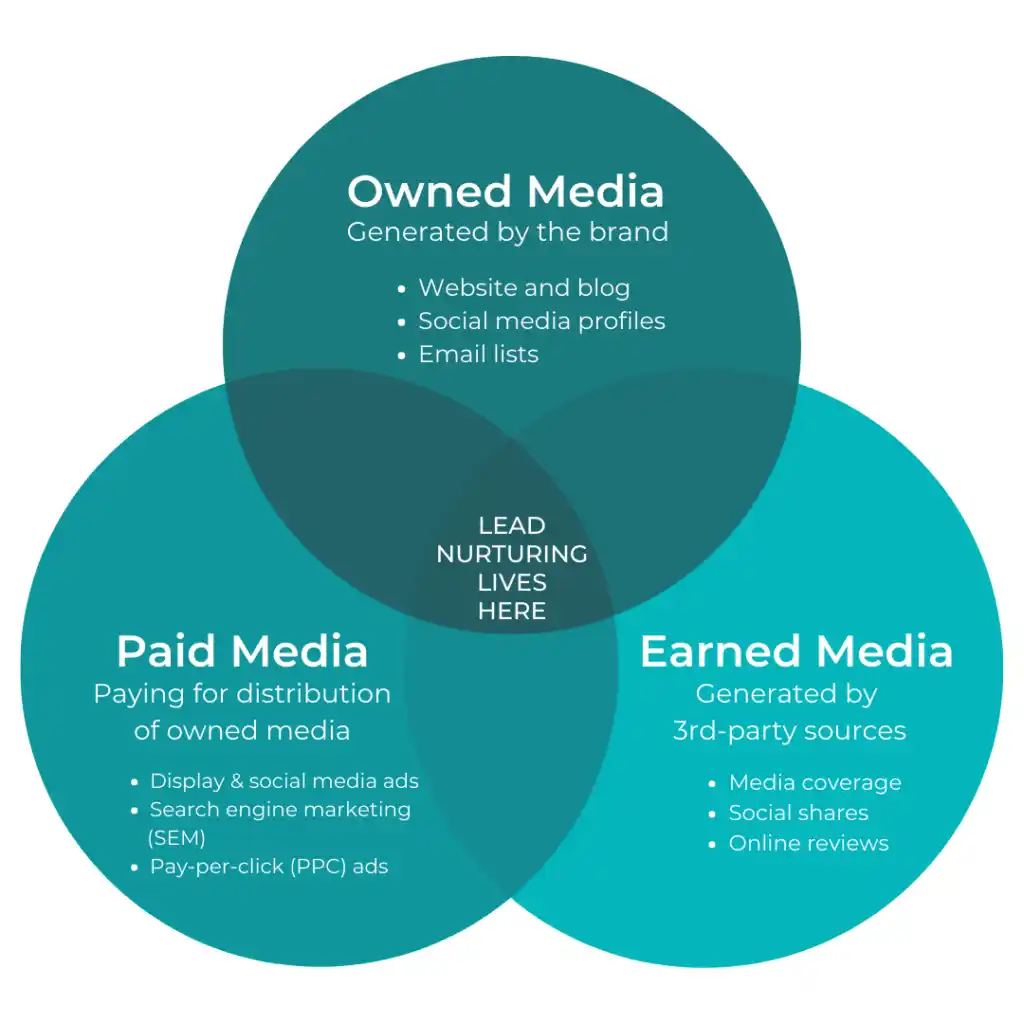
#2. Lead nurturing that focuses exclusively on new customers and ignores existing customers, is missing the point.
Instead of worshiping at the altar of acquisition, highly successful lead nurturing practices take the 30,000 foot view of all revenue opportunities.
For example, in a service-based or subscription/membership business model, lead nurturing tactics move customers who aren’t yet ready to buy through the funnel while also ensuring that current customers are sufficiently educated on the product and incentivized to remain loyal to the brand.
#3. The martech stack is sophisticated.
Many businesses don’t fully grasp the capabilities of the latest marketing technology (martech). And the tools are growing so quickly that brands that still rely on only the most basic analytics options are missing a huge competitive advantage.
Measurement in a lead nurturing program starts with lead scoring, which we’ll get to in a moment. From there (this is why the holistic channel mix is key), the marketing analytics and reporting function gets turned all the way up. And it stays on permanently.
#4. Don’t just measure behavior. Measure intent.
Only 3% of website visitors actually fill out forms and provide information about themselves. So how are you going to nurture all those anonymous people?
Martech tools like 6Sense help us measure intent signals, which are cues that highlight prospects and leads with greater interest in your product or service. Intent signals can be both implicit and explicit and are gathered from any available interaction point like website activity, search queries, social activity, and email responsiveness.
Accurately interpreting intent signals and then responding to them in the right format, at the right time, and in the right location (nailing each of those variables is VITAL) is what data-driven lead nurturing does so well.
Lead nurturing improves the marketing-sales relationship.
When marketing is sending sales marketing-qualified leads (MQLs) that show strong intent, this typically shortens the sales cycle, increases deal size, and improves resourcing efficiencies across both teams.
Let’s illustrate this with an intent signals example:
Lead A: One person from this company visited your website 12 times in the past month and signed up for your webinar or ebook in the process.
Lead B: One person from this company visited your website once in the past month and signed up for the same webinar or ebook. A few days later, 12 other people from that company viewed the ebook or webinar URL and have each visited your website at least once a week since then.
Which lead’s intent signals represent the greatest (fastest) conversion opportunity?
Lead B’s initial website visitor was an information-gatherer who then passed your brand’s marketing/educational content on to others within the company.
Tracking the subsequent behavior of those 12 individuals shows us that multiple internal stakeholders are interested in and appear to be having recurring conversations about your offering. This group of 12 people most likely includes the decision-makers that make up the buying group for your product/service.
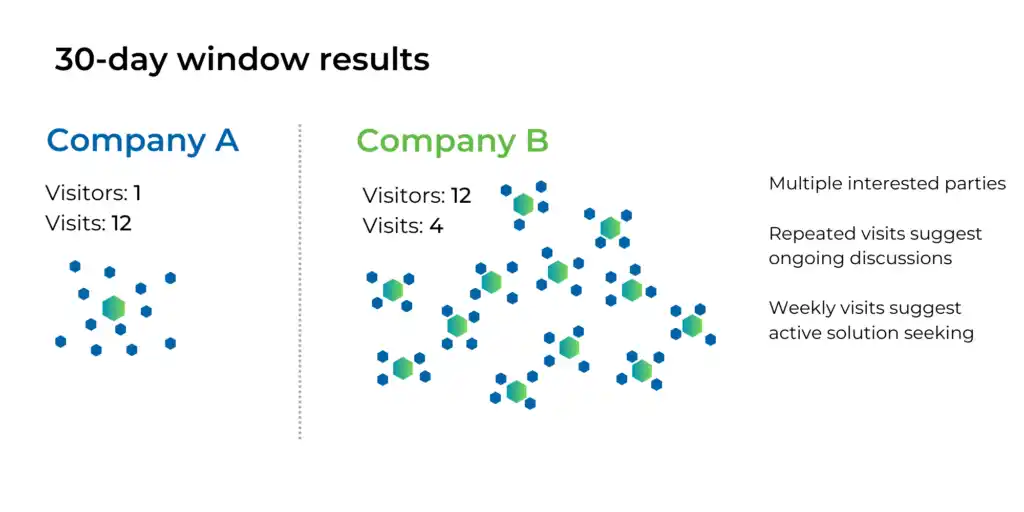
Lead nurturing develops strategies for nurturing those 12 unidentified people. Depending on the size of your/their organization, this could include anything from social and search retargeting ads to personalized outreach.
*EXTRA TIP* Before you sign up for 6Sense, make sure your Ideal Customer Profile and personas are thoroughly defined, and that you have an experienced analytics consultant or in-house team member. We’ve seen too many brands invest in big tools without the foundational assets and subject matter expertise needed to successfully utilize those tools.
3 highly effective lead nurturing tactics
We wouldn’t be us if we published a blog post that didn’t include at least one “Red flag alert!” Here’s the one you need today:
Every marketing tactic has been successful at one moment. But, CONTEXT.
That tactic was successful for that audience and that organization, at that single moment in time. Next month, things could change. This is why we strongly recommend analyzing tactics for contextual relevance for your specific business and product, and then implementing your conclusions through a variety of interconnected marketing activities instead of depending on a single platform, tactic, or tool.
How to use data tools to grow Peek inside an Apiary client-partner story to see how quickly turning on/off a single tactic can hit revenue
The 3 most common lead nurturing tactics:
1. Lead scoring
Lead scoring is the process of evaluating leads based on a customized set of criteria (demographics, firmographics, budget, authority, purchasing timeline, website browsing behaviors, search queries, conversion events, or even social interactions) that ranks the lead’s level of interest and likelihood to purchase.
Lead scoring, in conjunction with analyzing a lead’s intent signals, should be the basis of all content marketing efforts, informing both the type of content created, the key narrative elements of that content, and exactly when and how it reaches the lead.

2. Highly contextual content marketing
Particularly for brands with long sales funnels that require buy-in from multiple stakeholders, it’s crucial to document the various buyer personas involved so that you can distribute highly targeted content that satisfies their individual pain points, goals, and education gaps.
Your marketing automation platform should streamline the process of identifying, segmenting, and targeting each persona as they move through the funnel.
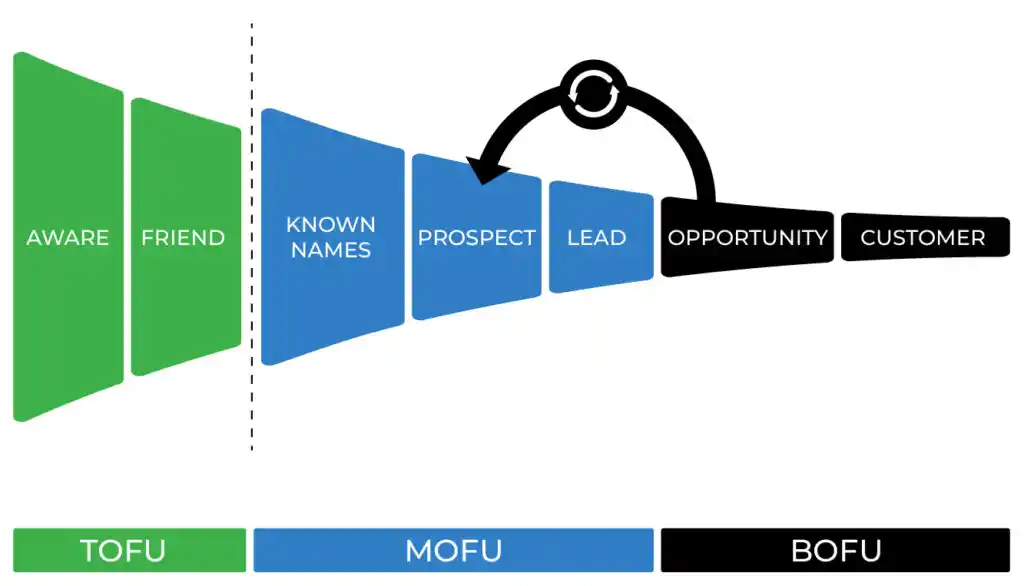
Top of the funnel (TOFU)
Total addressable market. Aware of your business but may not be a qualified lead yet.
Middle of the funnel (MOFU)
Self-selectors. Engaging with your content and likely showing buying intentions.
Bottom of the funnel (BOFU)
Qualified leads. Pass to sales or start sending pricing, demos, discounts, etc.
3. Personalized email marketing
Email marketing remains a highly-leveraged marketing activity, provided you personalize emails based on distinct buyer personas and lead segmenting.
However, like all lead nurturing tactics, email marketing does not thrive in isolation.
Leads need to be carefully monitored by the sales and marketing teams equally, so that the marketing funnel turns off when a lead moves into the sales pipeline, and vice versa if a sales lead needs to return to the marketing funnel for any reason.
Lead nurturing is fanatical about delivering the most delightful user experience. Over-emailing leads is anything but delightful.
Lead nurturing campaign examples
Here are a few examples of lead nurturing in action with our Apiary client-partners:

For a highly technical B2B brand, we launched a niche webinar campaign series, supported by segmented emails, and shared insights with the sales team in advance of networking events where they’d be interacting with these leads.

For a D2C consumer-packaged goods brand, we created automated drip email campaigns for multiple customer segments based on previous purchasing behavior and AOV.

For a B2B digital marketing platform, we developed a multi-pronged campaign that integrated PR placements, media buys, and a highly targeted email campaign.
Explore our Client-Partner Case Studies for more lead nurturing examples.
TL;DR on lead nurturing
- Lead nurturing is a highly targeted approach to marketing that engages potential customers over a period of time
- Highly successful lead nurturing is defined by lead scoring, a holistic mix of customer touch points at strategic intervals, and measuring and acting on intent signals, with the goal of generating both net new conversions and improved customer retention rates
- Lead nurturing delivers ROI by meticulously analyzing where each purchasing decision-maker sits inside the funnel and delivering highly contextually-relevant content to each segment at the right time.
